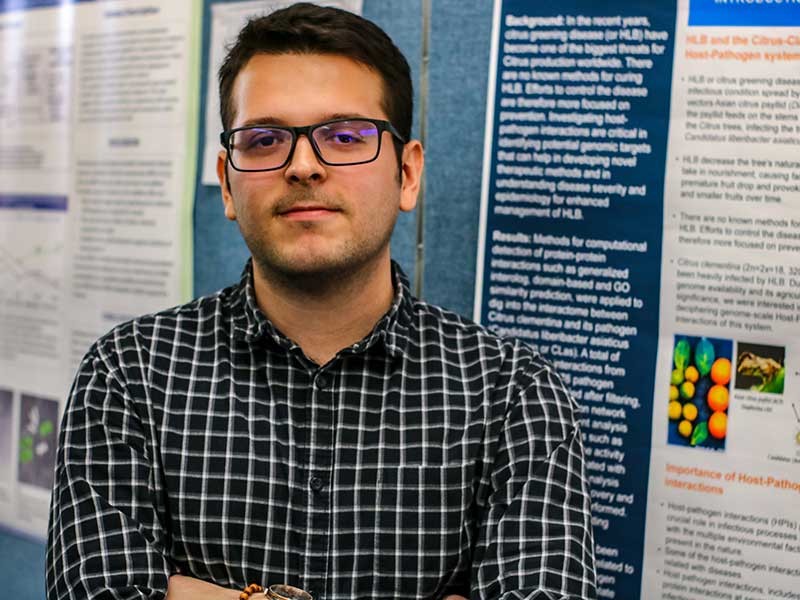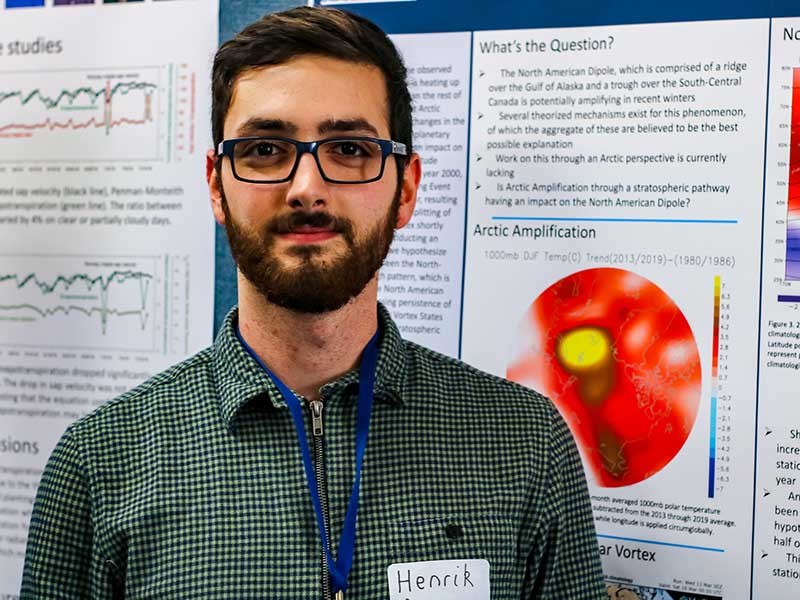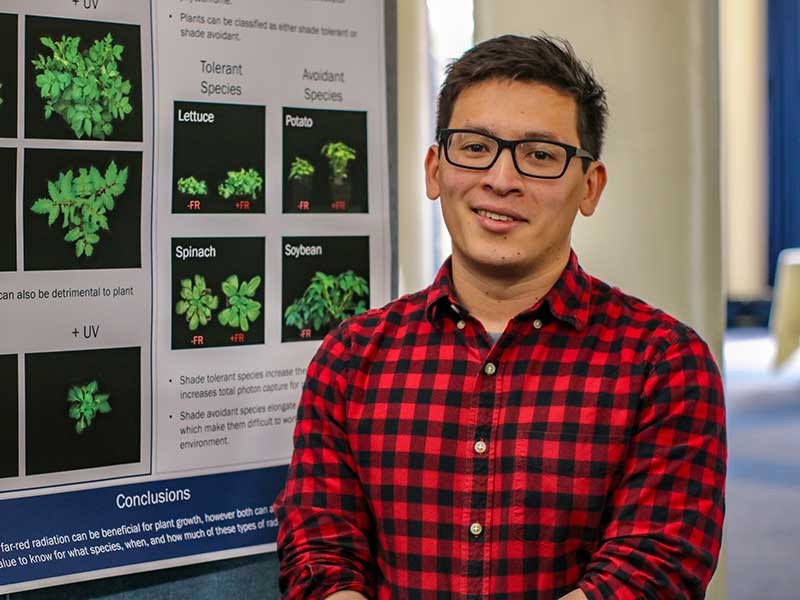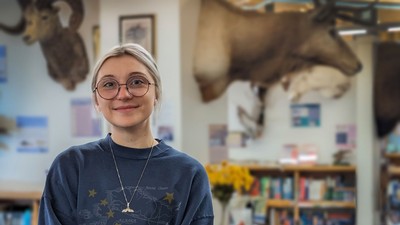Plants, Soils and Climate Student Showcase Presents Diverse Research
By Bronson Teichert |
Katie Slebodnik studies fixing nitrogen in soils.
Students in the Department of Plants, Soils and Climate (PSC) at Utah State University are conducting research with world-renowned scientists in the College of Agriculture and Applied Sciences. The students’ work covers a broad range of environmental issues and emphasizes the need to feed people and animals while protecting and preserving the world we share.
During the recent PSC Student showcase, a total of 51 undergraduate and graduate student scientists presented their research to peers, advisors and faculty.
Katie Slebodnik worked on soil research as an undergraduate at the University of New Hampshire and worked in a soil fertility lab focused on agricultural systems. She continues her soil research as a graduate student at Utah State University.
“I’m using different compounds found in different plants that might be able to help hold nitrogen in the soil and keep it from going into your water and air, specifically in pastures,” Slebodnik said.
Alfalfa is one of the main crops grown in Utah and fit perfectly into Slebodnik’s research because of its ability to improve nitrogen retention in pastures. After an 84-day study monitoring nitrogen retention, results from the pasture treatment yielded lower carbon and nitrogen.
“I hope to be done by the end of the summer,” Slebodnik said. “I would really like to work in some sort of Extension or outreach position where I can bridge the gap between knowledge and practice.”
Cristian Loaiza, a student researcher, is not a typical PSC student. He completed his undergraduate degree in computer science in his home country of Columbia, but soon lost interest in the computer science world. Loaiza discovered an interest in biology and eventually moved from computers to studying disease in citrus fruits.
Loaiza’s research is focused on interactions between plants and pathogens, specifically the citrus greening disease which has decreased citrus fruit production by 60 percent since the 1990s. He said there is no cure for this disease, but his research could lead to solutions that mitigate the disease.
“I think it is very important to be cautious of the decisions that are causing these epidemics in the U.S.,” Loaiza said. “I think we need to be very careful about which strategies we are going to implement to mitigate the big impacts from diseases.”
Researching citrus fruits, which don’t grow well in Utah, is challenging Loaiza said. Collaborating with growers and other researchers in California has been one of complications of his research, but finding solutions to help farmers to stay in business is what keeps him moving forward.
Climate systems student researcher Henrik Panosyan is working to understand drastic and rapid temperature changes near at the Earth’s poles as Arctic amplification is heating up the polar regions 2-3 times faster than the rest of the globe.
“We really don’t have a good idea after all on what is going to happen even years from now,” Panosyan said. “We try to make the best predictions we can, but Arctic amplification is one of the examples of proof that we really don’t know. Things may happen a lot faster than we can predict or things can happen a lot slower than we can predict. There is a ton of work to be done.”
Panosyan said impacts of rapid polar warming are being recorded in Siberia, eastern Asia, Eurasia and Europe. He is working to discover how polar temperature changes may also impact the United States.
Bruce Bugbee, a professor of plant physiology, has gained attention for his research growing plants in different types of controlled conditions, including aboard spacecraft. Bugbee is the advisor to Paul Kusuma, a graduate student focusing on how light will impact growing plants on Mars.
“We can’t grow plants on the planetary surface because the atmosphere is too thin, there is too much radiation and an increase of meteor damage,” Kusuma said. “So we need to grow plants underneath the surface of Mars, but we still need to get light to the plants.”
There are two options for delivering light to plants in those conditions according to Kusuma: Using solar panels and electric lights or using a combination of concentrating mirrors and fiber optics. He said the latter option is about seven times more efficient than the former, so that is what he is concentrating on in his research.
“I still can’t believe that I’m doing this,” Kusuma said. “About three years ago, I was unsure if I even wanted to go to grad school and here I am working on a pretty interesting project. I really enjoy working on this because it has applications beyond just Mars. It has plenty of applications here on Earth.”
Back on Earth, student researcher Rachel Keen is investigating why some ponderosa pines survive western pine drought, beetles and wild fires. Keen looked at tree rings to determine times of drought which made trees more susceptible to pine beetles, increasing rates of mortality.
“There are a lot of similarities between this western pine beetle outbreak in California and the spruce beetle outbreak here in Utah,” Keen said. “In these kinds of studies, we’re trying to figure out what areas and which characteristics give the best chance of survival and what areas we can focus on protecting and keeping out of timber harvest to improve more of the forest and that increase survival of events like this.”
Keen found that most trees that survive times of environmental stress have fast rates of growth over their century-long life spans. She wants to start working on develop ways to prevent tree mortality, but knows it will be complicated research. Keen said there will not be a one-size-fits-all solution to solve the problem.
Cristian Loaiza studies plant pathogens, specifically citrus greening disease.
Henrik Panosyan's research focuses on rapid temperature change in the Arctic.
Paul Kusuma investigates strategies for growing plants with artificial lighting.
WRITER
Bronson Teichert
Multimedia Marketing Manager
College of Agriculture and Applied Sciences/USU Extension
Bronson.teichert@usu.edu
CONTACT
Paul Johnson
Department Head
Department of Plant, Soils and Climate
Paul.Johnson@usu.edu
TOPICS
Plants 186stories Undergraduate Research 156stories Soils 27storiesComments and questions regarding this article may be directed to the contact person listed on this page.












